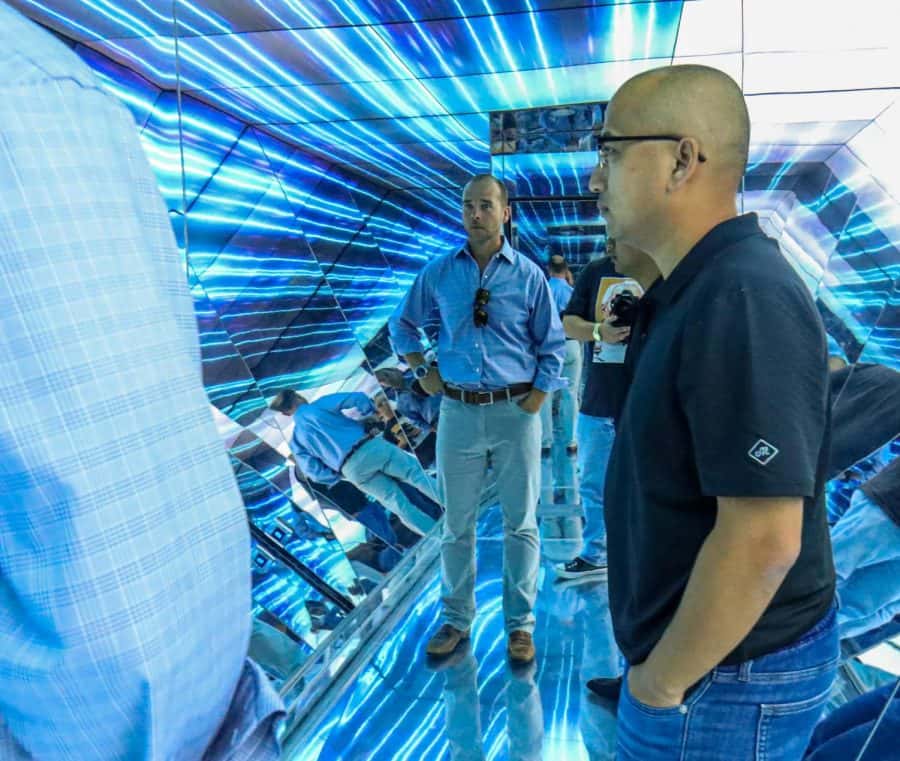Lockheed Martin seeks UA engineers with challenge box
September 12, 2019
The Challenge Box occupied the Ferguson Center Great Hall for three days this week as part of a recruitment push by Lockheed Martin Space. The company challenged STEM majors to solve problems developed by their own engineers, identifying potential new hires along the way.
It looked like something out of Harry Potter, an unearthly black box standing 14 feet tall and weighing 12,000 pounds. And if you didn’t see it put together, you may have been convinced that Lockheed Martin’s Challenge Box teleported into the Great Hall of the Ferg.
Serving as a lead-up to Lockheed Martin’s career fair on Sept. 11, the Challenge Box presented STEM majors with three engineering problems per day starting Sept. 9. Students worked alone, in pairs or in teams to enter one of their solutions by 4 p.m.
“The problems on the box are written by our engineers at Lockheed who build real spacecraft,” Alex Walker, marketing manager for Lockheed Martin Space, said. “Some of these problems were real problems that they had to solve to put those craft into space.”
Challengers who entered the correct solution unlocked a hidden door and were able to enter the box. Inside, the box greeted them with an immersive animation of space travel created by mirrors and screens covering the interior.
Winners received a box set of the Voyager records, humanity’s message in a bottle NASA sent into space in 1977, along with pins and stickers commemorating Lockheed Martin’s historical accomplishments in space.
But the high-value question, given on Monday and solved over the three days, was what caught the eye of many students. The problem was far more difficult than any of the daily questions. The prize for solving it was the stuff that dreams are made of: an on-the-spot job offer from Lockheed Martin Space.
“If you can solve these problems, you have what it takes to work with us,” Joe Portnoy, Lockheed Martin Space recruiting and marketing manager, said.
Lockheed Martin created the Challenge Box in early 2018 as a way to attract potential hires at recruitment conferences and college campuses. Engineering students and STEM majors flocked to the idea of a challenge, as well as the opportunity to be noticed by a major company.
“I definitely would want to work at Lockheed Martin or one of those big aerospace companies,” Daniel McCully, a junior majoring in aerospace engineering, said. McCully correctly answered Tuesday’s question 2, which asked students to determine the surface temperature of Mars through several hints and equations. “Getting a leg up on recruitment and an internship there would be really nice.”
This is the latest in a large recruitment effort by Lockheed Martin, all to win “the talent war.” There are over 900 space technology companies in the U.S., forcing recruitment to be more competitive, Walker said. The University of Alabama is the third college campus for the Challenge Box to visit.
“We went to our [human resources] department and our global talent acquisition department and asked where we should go to recruit the brightest minds in engineering,” Walker said. “They gave us a very short list, and we based our decision solely on what sort of employees HR said we needed … It was the strength of the engineering program at The University of Alabama that brought us here.”
Though UA students are attractive hires for Lockheed Martin, it is another thing entirely to appear as an attractive employer. Corporate culture and gender equality are becoming deal breakers for college graduates in the #MeToo era.
Engineering is a historically male-dominated profession. Women make up 17% of engineers employed in the U.S., according to a 2015 study by the National Science Foundation. Statistics are worse for aerospace engineers: 14% of those employed are women.
Olivia Ustas, MBA and civil engineering graduate student, interned at Lockheed Martin for the past two summers.
“Interning for Lockheed Martin definitely filled that [gender] gap,” Ustas said. “[Gender] is a little bit of an intimidating factor in the civil engineering field, but going into that industry within the Lockheed Martin area was not only welcoming, but very embracing. It was the best environment for me to get hands-on experience while also feeling included and enjoy coming to work every day.”
Lockheed Martin supports several organizations at the community level that encourage girls to get involved in STEM fields. Full recruitment efforts don’t begin until high school internship programs.
The Women Impact Network is a professional development organization for women employed at Lockheed Martin. Women involved have the opportunity to lead high school and college internship groups. Seeing women in engineering jobs helps students know what’s possible for them, employees say.
“Representation matters to us at Lockheed,” Joe Portnoy, Lockheed Martin Space recruitment and marketing manager, said. “Encouraging young women and people of color to go into STEM fields is something we’re invested in.”








